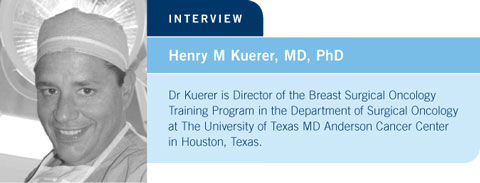
 |
||||||||||||||

| Tracks 1-8 | ||||||||||||||||||
|
Select Excerpts from the Interview
Track 4
![]() DR KUERER: It makes sense to me that tamoxifen will have an effect on
DCIS with estrogen expression, but many of us in the community would like
to see those data published. It’s one of the few studies that has been presented
only in abstract form, at least in the United States, and changed our standard
therapy of only offering patients tamoxifen in the setting of DCIS with
positive estrogen receptors.
DR KUERER: It makes sense to me that tamoxifen will have an effect on
DCIS with estrogen expression, but many of us in the community would like
to see those data published. It’s one of the few studies that has been presented
only in abstract form, at least in the United States, and changed our standard
therapy of only offering patients tamoxifen in the setting of DCIS with
positive estrogen receptors.
![]() DR LOVE: One of the things that bothered me is that when he tested tumors
and found them to be ER-negative, they did not respond to or benefit from
tamoxifen, but because there were so many false-positive results, among those
tumors tested in the community, for example, benefit was recorded in ER-negative
tumors. What are your thoughts about that?
DR LOVE: One of the things that bothered me is that when he tested tumors
and found them to be ER-negative, they did not respond to or benefit from
tamoxifen, but because there were so many false-positive results, among those
tumors tested in the community, for example, benefit was recorded in ER-negative
tumors. What are your thoughts about that?
![]() DR KUERER: It’s a big concern — that is, testing and whether or not we are
accurately identifying the right patients to treat. The same problem arises with
HER2 testing.
DR KUERER: It’s a big concern — that is, testing and whether or not we are
accurately identifying the right patients to treat. The same problem arises with
HER2 testing.
![]() DR LOVE: It would seem that surgeons would want patients seeing a medical oncologist for a postoperative visit to discuss adjuvant therapy and have as
accurate as possible ER and HER2 test results at that time. How do you
approach that situation?
DR LOVE: It would seem that surgeons would want patients seeing a medical oncologist for a postoperative visit to discuss adjuvant therapy and have as
accurate as possible ER and HER2 test results at that time. How do you
approach that situation?
![]() DR KUERER: In general, unless we know the testing laboratory, we repeat
everything at MD Anderson prior to sending the patient to the medical
oncologist. A discrepancy occurs for about 20 percent of the patients, so we
feel comfortable repeating it. Of course you have to trust your labs, but you
have to employ a lab that has a lot of experience using the right positive and
negative controls. You have to demand that for your patients.
DR KUERER: In general, unless we know the testing laboratory, we repeat
everything at MD Anderson prior to sending the patient to the medical
oncologist. A discrepancy occurs for about 20 percent of the patients, so we
feel comfortable repeating it. Of course you have to trust your labs, but you
have to employ a lab that has a lot of experience using the right positive and
negative controls. You have to demand that for your patients.
Track 8
![]() DR KUERER: In Europe, a lot of postmenopausal women with ER-positive
disease have been treated with endocrine therapy in the neoadjuvant setting.
A good study was published five years ago (Eiermann 2001) with postmenopausal
women who had large primary tumors that were ER-positive — in fact,
these patients were ineligible for breast-conserving surgery. It was a randomized
study of tamoxifen versus an aromatase inhibitor.
DR KUERER: In Europe, a lot of postmenopausal women with ER-positive
disease have been treated with endocrine therapy in the neoadjuvant setting.
A good study was published five years ago (Eiermann 2001) with postmenopausal
women who had large primary tumors that were ER-positive — in fact,
these patients were ineligible for breast-conserving surgery. It was a randomized
study of tamoxifen versus an aromatase inhibitor.
The results never fully made it to the surgical community, but 45 percent of the patients in the aromatase inhibitor group were converted from needing a mastectomy to being able to undergo safe breast-conserving surgery. It’s remarkable because it’s a higher conversion rate than we see with unselected patients who are receiving neoadjuvant chemotherapy. Many patients in our country are not interested in undergoing systemic chemotherapy. This is something that we surgeons need to consider and get more experience with.
The American College of Surgeons Oncology Group is opening a trial now (ACOSOG-Z1031). It’s a three-arm study of approximately 300 patients who are postmenopausal with ER-positive disease and will receive neoadjuvant aromatase inhibitor therapy in a randomized manner using one of the three current agents: anastrozole, letrozole or exemestane.
We’re hoping we’ll be able to convert some of these patients from needing a mastectomy. It will also give surgeons experience on how to follow these patients — that is, initial examinations, follow-up visits using ultrasound and mammography and marking the area where the tumor is so we’ll know where to resect with percutaneously placed clips.
| Table of Contents | Top of Page |